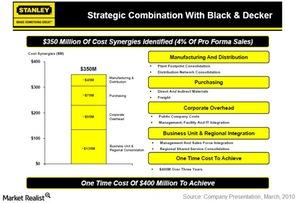How Stanley Black & Decker Came to Be
Stanley Black & Decker (SWK), a Fortune 500 company, is the world’s leading tool company. It provides a wide array of products to the construction (XHB) and automobile (FSAVX) end markets.
April 1 2016, Published 1:05 p.m. ET

Introduction
Stanley Black & Decker (SWK), a Fortune 500 company, is the world’s leading toolmaker. The company provides a wide array of products primarily serving the construction (XHB) and automobile (FSAVX) end markets. The company’s offerings include hand tools, power tools, garden tools, mechanics tools, and hydraulic tools. The company came into existence in 1843 and changed its name to Stanley Black & Decker after its merger with Black & Decker in 2010. We’ll dig deeper into the details of the merger in this part.
Before the merger
Before the merger, Stanley Black & Decker was known as the Stanley Works Company. Stanley Works operated as a hand tool and construction equipment manufacturer and had earned revenues of $3.7 billion in 2009. The target company, Black & Decker, was a power tools provider. Black & Decker made $4.8 billion in 2009 with 73% of it coming from its power tools business, 11% from fastener solutions, and the remaining from the hardware and home improvement business. As seen in the product mix, there was little overlap in their businesses despite being in the same industry. Therefore, the EU Competition Commission approved the merger, and the deal materialized in March 2010.
Details of the deal
Stanley Works acquired Black & Decker in a stock swap valued at $4.5 billion. Under terms of the deal, Black & Decker shareholders received 1.3 shares of Stanley for each share of Black & Decker, an implied premium of 22% then. The company based its decision on expected cost synergies of $350 million, or 7% of Stanley Works’ annual sales. Stanley Works also expected potential revenue synergies arising out of cross-selling opportunities and expanded the reach of product distribution of the combination.
Shareholder approval
Shareholders overwhelmingly approved the integration, as the stock outperformed the S&P 500 by a wide margin. In the five-month period between November 2009 and March 2010, the stock rose by 29% as opposed to the S&P gain of 12.5%. We’ll discuss more on Stanley Black & Decker’s (SWK) stock returns in part 11 of this series. We’ll discuss the company’s valuation relative to peers such as Tyco International (TYC) and Snap-on (SNA) in part 13 of this series.
Stanley Works revises estimates
The success of the integration is highlighted by the fact that Stanley Works ended up underestimating the potential cost savings by a wide margin. The company had to revise its savings estimates upward twice, initially to $450 million and later to $500 million. The bulk of savings came from streamlined manufacturing and purchasing, which led to reduced selling, general, and administrative expenses.
How did the two companies evolve as leaders in their respective product lines? We’ll discuss this in part two of this series.
